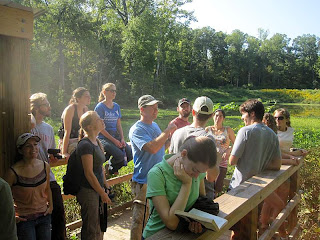There have been quite a few recent local reports of Yellow-bellied Flycatcher, a rather rare migrant to North Carolina. It seems that this is either a great fall to see the species or a great fall to see another of the confusing Empidonax flycatchers, such as a first-year Acadian with yellow-washed belly, and report it as a Yellow-bellied.
Without hearing birds of this genus vocalize, identification can be quite tricky, and many a cautious birder will stick with Empidonax sp. Even under ideal viewing conditions.
Take this bird I photographed at Brickhouse Road over the weekend…
Not a great look, but definitely some sort of empid.
Moments later I came upon another empid. that may or may not have been the same individual. This one clearly had a yellow belly, green back and even a yellowish-looking throat.
I followed it for several salleys along the path and it spent time along the forest edge on both the more mature side as well as the denser, younger wet side.
After a while it took a break from foraging and settled cooperatively for a few minutes in this tree.
What's it doing eating a caterpillar? I thought these things were supposed to catch flies!
So this post has turned into an ID quiz for which I have no answer key. Can anybody tell me what this bird is?
Previously I had never seen an immature Acadian nor a Yellow-bellied Flycatcher. Surely this bird is one or the other… but which?
If the photos aren’t enough… Check out this video…
No it doesn't vocalize or do anything super-exciting. It just looks around, and more importantly stays in focus (I have several other clips in which my camera decided that a twig was far more interesting.)
I'll admit I'm not flycatcher expert, but I'm starting to lean toward Sierran Elaenia =P
I'll admit I'm not flycatcher expert, but I'm starting to lean toward Sierran Elaenia =P
After consulting carolinabirds and frontiers in bird identification listservs there was no consensus among expert opinion. I think I got a total of 5 votes for Yellow-bellied and 4 votes for Acadian. In general folks in the Acadian camp were more confident in their ID.
Jeff Pippen's advice was probably best: go get Ken Kaufman's book and figure it out yourself.
So I ordered: the Kaufman Field Guide to Advanced Birding
The section on empids is really helpful for determining which attributes are most useful (i.e. bill size/shape, primary projection) and which are not (i.e. color, tail flicking).
The main problem with the pictures I posted is that they show more of the less-useful indicators. I captured the bill from several different angles, but it's size seems to change from one photo to the next.
The result was a crazy juxtaposition of comments, such as...
Expert A: "...the smaller bill...seems to point towards Yellow-bellied."
Expert B: "The bill is clearly broader at the base, longer, and pointier than Yellow-bellied, Least, or Willow/Alder Flycatchers."
So I went back to my original photos and videos and found that some of my "bad" pictures actually illustrate the important field marks better than the "good" photos above.
In these photos (of the same individual) the bird here is in direct sunlight and the color is washed out...
...BUT the primary projection is shown much more clearly
...AND it is easier to see the width of the base of the bill.
The apparently broad bill seems to fit much better with Acadian than Yellow-bellied.
The primary projection also looks to be long...perhaps not too long to rule out Yellow-bellied on its own, but I think it also favors Acadian.
So after chasing my tail all over the place and being pulled apart by conflicting opinions, I'm right about where I started with my best guess for the ID.
Big thanks to everybody who has commented and emailed me about this bird...especially to those who voted for Yellow-bellied Flycatcher! Unfortunately I don't think I can, in good faith, mark it down as such (especially since it would be a life tick).
I've certainly learned a lot and hope others have as well. Also, further comment and discussion is more than welcome.















